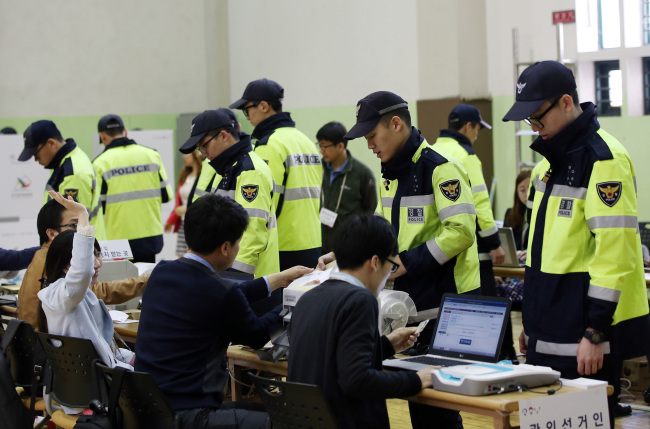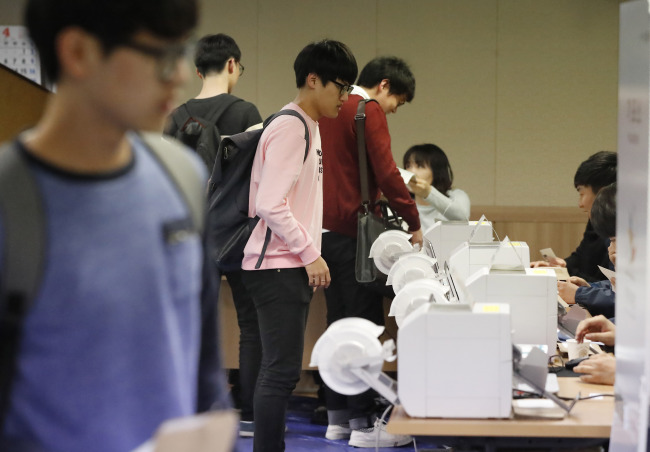South Korea on Friday kicked off its two-day early voting for the 20th general election, five days ahead of the official polling day, hoping to boost the turnout by allowing voters to cast their ballot in advance.
While candidates visited their polling stations early morning to vote and encourage supporters to follow suit, the leaders of main parties canvassed the Seoul-Gyeonggi metropolitan belt, striving to rally votes from undecided swing voters.

On Friday, the first day of the preliminary voting for the April 13 general election, soldiers, police and young voters cast their ballot at polling stations nationwide. Yonhap
The early voting, which will be run from 6 a.m. to 6 p.m. on Friday-Saturday, enables voters to cast their vote at a designated polling station, according to the National Election Commission.
The voter is only required to suggest a personal identification. No advance registration or document is necessary.
The election watchdog also installed three polling booths at Seoul Station, Yongsan Station and Incheon International Airport, offering voting convenience for travelers, officials said.
Early votes, despite the limited number of participants, are seen to mirror the final election results.
Back in the 2014 local election, when the early voting system was implemented for the first time, the early turnout acted as a litmus test of the results. While the early votes are opened and counted concurrently on the actual voting day, the turnout rate is deemed to serve as a stimulus in encouraging undecided voters to turn up. In 24 out of the 25 districts in Seoul, the candidate who took the lead in early voting also ended up victorious.
This year’s early voting rate stood at 3.92 percent as of 3 p.m. Friday, involving some 1.6 million of the nation’s voting pool.

On Friday, the first day of the preliminary voting for the April 13 general election, soldiers, police and young voters cast their ballot at polling stations nationwide. Yonhap
Pressed by the lack of time remaining up to the final race, key party leaders focused their energy on canvassing the metropolitan region, consisting of 122 out of 253 constituencies and embracing the largest number of fluctuating voters.
Rep. Kim Moo-sung of the ruling conservative Saenuri Party toured Seoul’s outskirt areas, from Anyang, Bucheon, Gimpo, Goyang and Paju, making a second trip to Gyeonggi Province since the official campaigning period began.
He continued his low-profile stance, offering apologies for the party’s infighting over candidate nomination and asking for “one more chance.”
His opposition counterpart, Kim Chong-in of The Minjoo Party of Korea, started off his day by stumping in Seoul’s northwestern Eunpyeong-B district and moved to Incheon’s Yeonsu-B for early voting.
He then swept the rest of Incheon, as well as the northern Gyeonggi areas such as Gimpo, Goyang, and Paju, before returning back to Seoul for late afternoon electioneering.
Rep. Ahn Cheol-soo of the No. 3 People’s Party took part in a vote-encouraging campaign held at Seoul Station early morning.
Former Minjoo chief Rep. Moon Jae-in, on the other hand, made his appearance in the nation’s southwestern city of Gwangju and the surrounding Jeolla Provinces for a two-day visit.
The potential presidential candidate’s move was a head-on challenge to reconcile with the longtime opposition stronghold, where the public sentiment has reportedly turned against the main opposition party for allegedly neglecting the region.
By Bae Hyun-jung (
tellme@heraldcorp.com)


![[AtoZ into Korean mind] Humor in Korea: Navigating the line between what's funny and not](http://res.heraldm.com/phpwas/restmb_idxmake.php?idx=645&simg=/content/image/2024/04/22/20240422050642_0.jpg&u=)

![[Exclusive] Korean military set to ban iPhones over 'security' concerns](http://res.heraldm.com/phpwas/restmb_idxmake.php?idx=645&simg=/content/image/2024/04/23/20240423050599_0.jpg&u=20240423183955)

![[Herald Interview] Why Toss invited hackers to penetrate its system](http://res.heraldm.com/phpwas/restmb_idxmake.php?idx=645&simg=/content/image/2024/04/22/20240422050569_0.jpg&u=20240422150649)
![[Graphic News] 77% of young Koreans still financially dependent](http://res.heraldm.com/phpwas/restmb_idxmake.php?idx=645&simg=/content/image/2024/04/22/20240422050762_0.gif&u=)